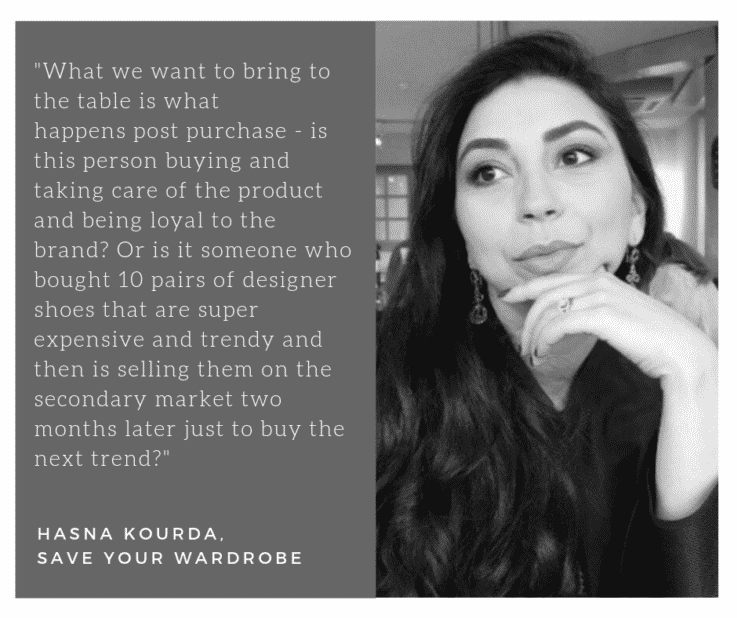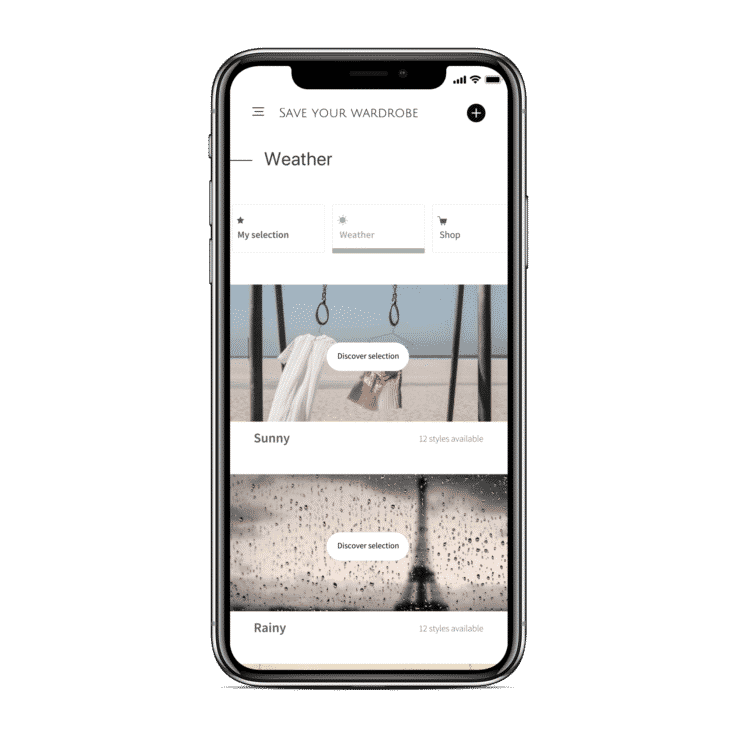Can Save Your Wardrobe’s digital wardrobe help you shop better?

How many unworn items of clothing do you own? How many have you only worn once or twice? For most of us the number is higher than we think. It’s for this reason that Save Your Wardrobe wants to digitise your wardrobe.
Its mission is to help us to buy less and buy better by knowing what we already own and how we use it. Save Your Wardrobe can then recommend new purchases that work with your existing wardrobe. It also can help stop items from languishing unworn by either arranging for them to be cleaned, altered or even sold or rented out.
With the app still in development, we sat down with founder Hasna Kourda to find out how it works and the challenge of integrating technology into the fashion industry:

Can you explain Save Your Wardrobe in a nutshell?
My background is in economics, corporate strategy and how to optimise resources when creating wealth. When I came to London almost six years ago I wanted to start a fashion career, but the common feedback was that I didn’t have enough retail experience and knowledge of the market in the UK.
I decided to start from the bottom again and worked as a retail sales assistant for six months. It was then that I realised that there was a big pain point from the customer perspective in that when they came to the store they didn’t know what they owned or what they wanted.
They were usually relying on the sales assistant and there was a very awkward relationship there because they were a little bit sceptical and suspicious of their intention.
At the same time, all of the technology that other industries were using already wasn’t available for the fashion industry. Every aspect of our life is now digitised, from money management to social networks to our calendar, but we rely on outdated ways to manage our wardrobe. From here Save Your Wardrobe came to life.
How does Save Your Wardrobe work?
We use online receipts to instantly build a digital version of your wardrobe. Customers allow us to access the email receipts from their online purchases and straight away they can see how many items they’ve bought, how much they’re worth, which is the oldest, which is the newest etc. We can then play on that data, depending on the season or the time of the year, to push you information that is relevant for you.
We are building an ecosystem of services that will help you make the most of your wardrobe and extend the life of your garment. This includes requesting ecofriendly dry cleaning or alterations or rental or even selling or donating straight through the app.
The idea is to keep the items in your wardrobe circulating. In the UK there is £10 billion worth of items hanging in our wardrobe that have never been worn. There’s actually a huge market opportunity that we are trying to solve.

Does it also make recommendations?
What we want to do is extend the narrative beyond the purchase. At the moment, when brands want to do a targeting campaign they rely on previous purchases made on that platform and demographics whether it’s age, gender or location.
What we want to bring to the table is what happens post purchase – is this person buying and taking care of the product and being loyal to the brand? Or is it someone who bought 10 pairs of designer shoes that are super expensive and trendy and then is selling them on the secondary market two months later just to buy the next trend?
We want to sort clusters of users so that the brands can better target and shape their messages and the services and products they send.

What is the business model of Save Your Wardrobe?
It’s a work in progress, but what we want to implement when we launch is being free for the user and getting a cut each time they request a service or shop from the platform. So, if we recommend something and they buy it we will get a commission, or if they request a service that we’ve recommended like dry cleaning or alterations we would get a cut.
Once we reach a critical mass of growth, we will start optimising these recommendations. We want to share our data with brands and retailers to let them know how the target audience is behaving once they buy, to help them understand their market and give strategic insights.
Where are you at with the product development?
We did things upside down. We started developing the technology and testing it, so the engine that will look for online receipts is ready and developed. We also have the computer vision engine, so if for example you have something that is old or you don’t have the receipt anymore, if you take a picture of it we will be able to know if it’s a shirt or a dress or a jacket or a coat. We will be able to know the colour and the main features so that you don’t have to manually input anything.
On top of that we’ve built a categorisation engine to make sure that the data we are collecting from these two different sources is harmonised. We then tested that with the first batch of beta testers and then we went through different events and conferences to test the UX of the app.
How long do you think it will be before Save Your Wardrobe goes live?
If we had the funding tomorrow, we could be live in two months. We have the service partners and we have the tech developed.

Is it hard to incorporate artificial intelligence into the model?
AI has been there for ages. Before it was just called statistics and equations and matrices.
This kind of data analytics in order to optimise and reduce waste has always been there.
Why is it only now that it has potential? It’s because the technology helps to make it quicker to test and implement this.
It’s a very big buzzword that people can think is out of reach, but it’s not that difficult. The fashion industry has always been very slow to adopt technology. It sees it as a very cold tool that doesn’t convey the emotions or the feeling of the fabric and the fit. I think that the new generation sees it as an opportunity.
What is difficult is the automation and the machine learning. We will always need a kind of bridge model between the machine learning and human selection.

Do you have a view on when AI will be able to match the recommendations and the reach of a human personal stylist?
It’s not a problem of technology. Technology is always advancing and progressing so even though today the technology is not ready it will be in two to three years. It’s about adoption and the way we think about technology when it comes to the fashion industry.
The mindset is not ready. There will be too much friction from people who are sceptical about sharing their data for example or sceptical about having a robot suggesting things.
That’s also the problem for Amazon. Amazon is automating your groceries, is automating your book purchases. All of these things you can actually just put on repeat and they will adapt to your need. But they are struggling to tap into the fashion industry. They don’t have the credibility to do that.

What other features would you like to incorporate in the future?
One of the first prototypes we made involved NFC tags that you would be able to read with your phone. We realised that the market wasn’t ready for that, so we put it a little bit further along in the roadmap.
I think that having a virtual fitting room or virtual avatar could help convert sales, but it needs to done in a way where you don’t have everything right back in your face. A component of the fashion industry you need to take into account is the fact that you need to seduce your customer. You need to be compelling. You need to sell a dream – you’re not selling reality; you are selling a better version of yourself.
Images courtesy of Save Your Wardrobe
How is the fashion industry changing? Here’s 19 innovations that will inspire you. Find out how we can help you identify and discover the breakout trends in offline and online retail that will put you years ahead of your competition. Get in touch here.



